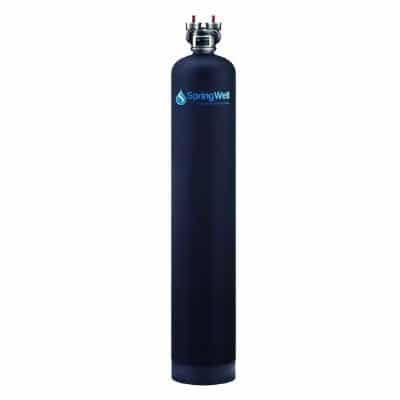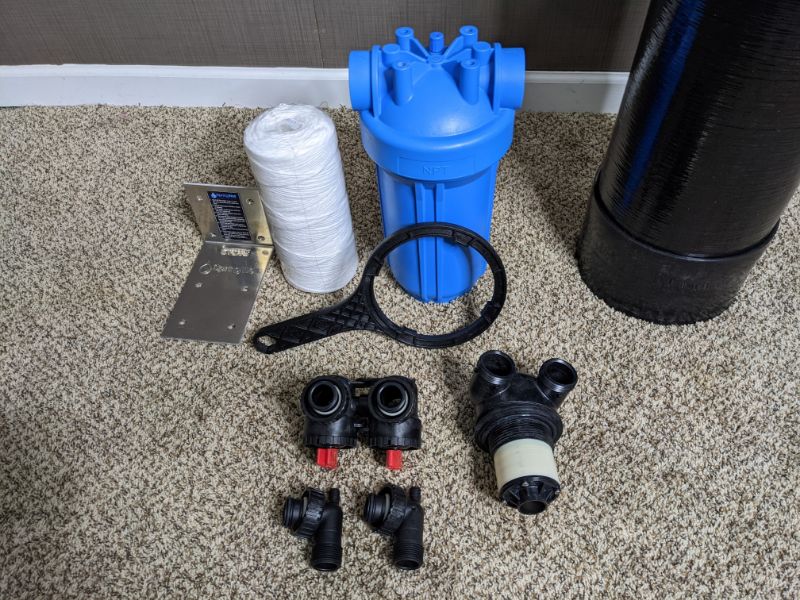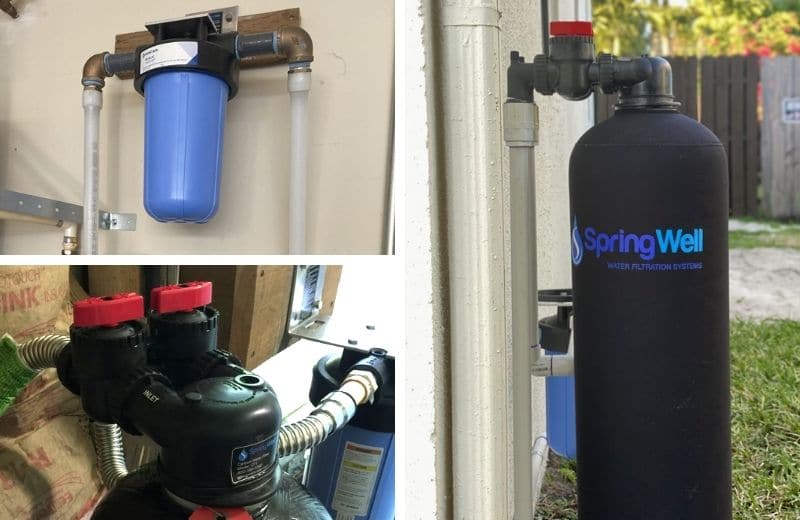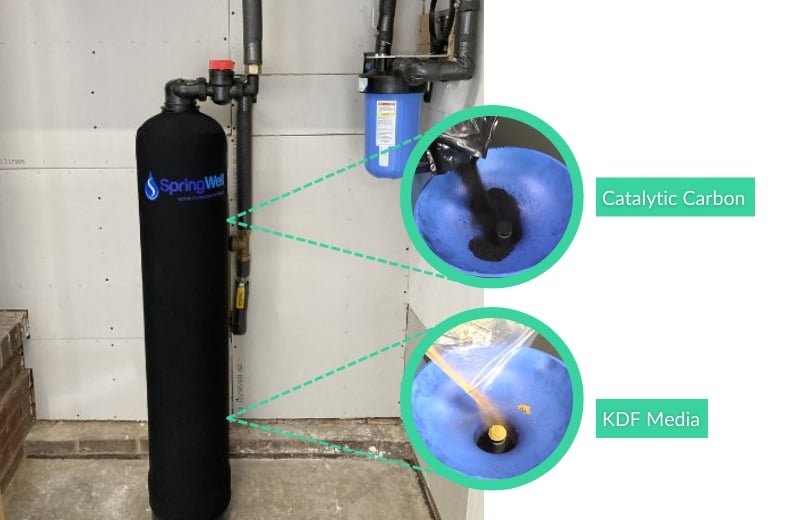
The SpringWell whole house water system is a high-capacity, low-maintenance option for whole home water filtration, suitable for chlorinated or chloraminated tap water. For this SpringWell CF review, we installed the unit in our own home and conducted comprehensive first-hand testing to measure its performance across a range of testing categories.
What We Like
What We Don’t Like
| Price | $1016.44+ |
| Contaminants Reduced | 10+ |
| Certifications | Not certified |
| Process | KDF + Catalytic Carbon |
| Filter Capacity | 1,000,000 gallons |
| Annual Cost | ~$40 |
| Warranty | Lifetime |
Table of Contents
📊 Scoring Data
We tested and reviewed the SpringWell CF1 system in our 2-bathroom home in Arvada, Colorado, measuring its performance across 6 key testing categories. We used these scoring data to calculate a combined, averaged overall score for the system. Here’s the key scoring data that we used to measure the SpringWell CF’s performance.
| Criteria | Results |
|---|---|
| Overall Score | 8.52 |
| Health Related Contaminants | 8.50 |
| Aesthetic Related Contaminants | 9.90 |
| Performance Certification | Not certified for any reduction claims |
| Filtration Rate | 9, 12, 20 GPM |
| Component Quality | Exceptional |
| Component Certification | Not certified |
| Setup | Weak |
| Servicing Requirements | Outstanding |
| Costs | $0.0013/ gallon |
| Warranty Length | Lifetime |
| Shipping | Free on orders over $29.99 in the continental US |
| Returns | 6 months with return shipping and 25% restocking fee |
🎬 Video Review
🚰 Contaminant Reduction
Score: 8.31Score: 8.31
We wanted to see how the SpringWell CF would perform when filtering our municipal water, and how its contaminant reduction abilities compared to SpringWell’s performance claims. We tested our water supply pre- and post-filtration to obtain objective data that we could use to measure the system’s performance in this category.
Another scoring factor for contaminant reduction was performance certifications. We checked NSF, IAMPO, and WQA databases to see if the CF system had obtained official certifications for reducing contaminants.

Our Performance Testing
Score: 8.57
We used a laboratory testing kit by SimpleLab Tap Score to test the SpringWell CF’s contaminant reduction performance. We were mailed a sample kit, which we used to take our water samples before shipping them to the lab for analysis.

To make sure our results were as reliable as possible, we followed the strict sample-taking protocol outlined by Tap Score.
We took two samples from the exact same faucet for each test:
- The first sample was the first use of the tap in the morning after water had been sitting in the plumbing overnight;
- The second was a fully flushed sample, meaning that we first let the water run for 5 minutes to clear out any stagnant water from the pipes.
This was to account for possible contaminants that could be leaching into our water from our plumbing.
The table below highlights the data we received, including which contaminants were present in our unfiltered tap water, and to what extent these were reduced by the SpringWell CF system.
| Contaminant | Measurement | Pre-Filtration | Post-Filtration | % Change |
|---|---|---|---|---|
| Barium | PPM | 0.0267 | 0.0158 | -41% |
| Bromodichloromethane | PPB | 0.00832 | 0 | -100% |
| Chloroform | PPB | 0.0208 | 0 | -100% |
| Cobalt | PPM | 0.0011 | 0 | -100% |
| Copper | PPM | 0.222 | 0.0532 | -76% |
| Fluoride | PPM | 0.6 | 0.5 | -17% |
| Lead | PPM | 0.0182 | 0.0007 | -96% |
| Manganese | PPM | 0.002 | 0.0013 | -35% |
| Molybdenum | PPM | 0.0016 | 0 | -100% |
| Nickel | PPM | 0.0125 | 0 | -100% |
| Strontium | PPM | 0.125 | 0.09 | -28% |
| Sulfate | PPM | 36 | 27.2 | -24% |
| Total THMs | PPB | 0.02912 | 0 | -100% |
| Zinc | PPM | 0.917 | 0.255 | -72% |
Health-Related Contaminants
Score: 8.50
Our unfiltered water contained trace levels of 15 contaminants with possible health effects, including chloroform, total THMs, bromodichloromethane (three disinfection byproducts), lead, nickel, fluoride, strontium, and barium.
Lead, nickel, and the three disinfection byproducts were the most concerning, having all been detected in concentrations higher than the HGL.
| Contaminant | Measurement | Detection | HGL |
|---|---|---|---|
| Chloroform | PPB | 20.8 | 0.22 |
| Total THMs | PPB | 29.12 | 0.32 |
| Bromodichloromethane | PPB | 8.32 | 0.0 |
| Lead | PPM | 0.0182 | 0.0 |
| Nickel | PPM | 0.0125 | 0.012 |
| Copper | PPM | 0.222 | 0.3 |
| Fluoride | PPM | 0.6 | 0.8 |
| Cobalt | PPM | 0.0011 | 0.002 |
| Sulfate | PPM | 36 | 500 |
| Zinc | PPM | 0.917 | 2.0 |
| Molybdenum | PPM | 0.0016 | 0.03 |
| Strontium | PPM | 0.125 | 3.0 |
| Manganese | PPM | 0.002 | 0.1 |
| Barium | PPM | 0.0267 | 2.0 |
| Sodium | PPM | 11.1 | 20 |
Some of the known health effects of these contaminants are:
- Developmental effects
- Immune function issues
- Carcinogenic (cancer-causing) effects
- Kidney and liver problems
- Reproductive effects
- Impact on the blood system
- Gastrointestinal effects
- Nervous system problems
- Skeletal health issues
- Impact on thyroid health
- Cardiovascular health effects
Our filtered water test results showed that the SpringWell CF was able to completely eliminate six of these contaminants, including all three disinfection byproducts.
It also reduced our water’s lead concentration by 96%, leaving a small detectable amount in the sample. This suggests that some of the lead contamination initially detected was coming from the home’s internal plumbing system after water passed through the filter.
As for some of the other heavy metals we were concerned about, the CF removed nickel and cobalt completely, and reduced copper by 76%, zinc by 72%, and barium by 41%.
The SpringWell CF didn’t do a great job with fluoride reduction– only 17% was reduced. But it’s not intended for fluoride reduction because it doesn’t contain any filtration media that targets this mineral, so we were pleasantly surprised that any fluoride was removed at all.
Aesthetic Contaminants
Score: 9.90
The only aesthetic contaminant that was detected in our unfiltered water was chlorine. We used the included chlorine test strip to obtain this data – chlorine is highly volatile and dissipates quickly, so it couldn’t accurately be detected by the lab.
Around 1 PPM of chlorine was present, which makes sense given that we use disinfected city water.
After installing the SpringWell CF, we tested our faucet water again, and this time, no chlorine was detected. The CF uses catalytic carbon media that effectively removes 99.6% of chlorine, plus chloramine, and in our own testing, it performed exactly as we’d expected and adsorbed the chlorine to untraceable levels.
Plumbing-Related Contaminants
Our pre-filtration tests also detected several plumbing-related contaminants, which were categorized because of their potential to leach from our pipes or cause damage to the plumbing in our home.
Lead and copper were the two key contaminants detected (0.0007 PPM and 0.0532 PPM respectively), which were most likely to have leached from our plumbing. Several other plumbing-related impurities were also detected: manganese (0.0013 PPM), sulfate (27.2 PPM), and zinc (0.255 PPM).
Post-filtration, the SpringWell CF had reduced lead by 96% (as mentioned above), copper by 76%, and zinc by 72%. Manganese had also been reduced to 0.002 PPM, but the system did not affect sulfate levels – these were actually slightly higher in the post-filtration test. Sulfate is safe in trace amounts in water, so we weren’t concerned.
Performance Certifications
Score: 6.00
There are hundreds of contaminants found in public drinking water, and our water only contains a small fraction of them. Performance certifications help us to understand how a water filtration system performs beyond the impurities it can reduce in our own water.
Unfortunately, we weren’t able to find testing to support the manufacturer’s performance claims, and the SpringWell CF isn’t currently certified for its contaminant reduction capability.
Obtaining an official certification is a long and costly process, especially for high-capacity systems like the CF, but we’re disappointed that SpringWell has not yet obtained certification as an extra vote of confidence.
| Contaminant | In Manufacturer Removal Claims? | Our Test |
|---|---|---|
| Chlorine | Yes | -100% |
| Chloramine | Yes | Not Tested |
| Haloacetic Acids | Yes | Not Tested |
| MTBE | Yes | Not Tested |
| TTHM | Yes | -100% |
| PFOA | Yes | Not Tested |
| PFAS | Yes | Not Tested |
| PFOS | Yes | Not Tested |
| Herbicides | Yes | Not Tested |
| Pesticides | Yes | Not Tested |
| Odors & taste | Yes | Not Tested |
| VOCs | Yes | Not Tested |
| Cobalt | No | -100% |
| Nickel | No | -100% |
| Copper | No | -76% |
| Zinc | No | -72% |
| Barium | No | -100% |
| Fluoride | No | -17% |
We still wanted to compare the contaminants that the CF reduced in our testing with the contaminants it’s claimed to reduce.
The system did a great job of reducing chlorine and THMs, as well as poor tastes and odors. The fact that it also reduced cobalt, nickel, copper, zinc, barium, and some fluoride was a bonus because these aren’t contaminants that SpringWell claims to address.
But we were unable to evaluate the CF’s ability to reduce the other contaminants listed on the product page – chloramine, PFOA, PFOS, pesticides, herbicides, haloacetic acids, VOCs, and sediment – because our water didn’t contain these impurities.
Related: Stay protected with the Springwell UV disinfection system
🚦Filtration Rate
Score: 10.00At the time of our review, we had a choice of three sizes and flow rates for the SpringWell CF system:
- The 9 GPM SpringWell CF1 Whole House Water Filter – for 1-3 bathrooms
- The 12 GPM SpringWell CF4 Whole House Filter System – for 4-6 bathrooms
- The 20 GPM SpingWell CF+ Whole House Water Filtration System – for commercial use
| SpringWell CF Configurations | Price |
|---|---|
| CF1: 1-3 Bathrooms | $1016.44 |
| CF4: 4-6 Bathrooms | $1199.66 |
| CF+: 7+ Bathrooms | $1737.20 |
We went for the SpringWell CF1, with a 9 GPM flow rate. To put this into perspective, most homes have an average flow rate of 6-12 GPM. You need a water pressure range of 25-80 psi for the system.
Post-installation, the CF1 had no impact on our flow rate or water pressure. This was exactly what we were looking for in a point-of-entry system – it was essential for us that we maintained our existing home’s flow rate to ensure that our appliances and fixtures had the same fast access to water whenever we switched them on.
📐 Design
Score: 8.40Design-wise, this SpringWell unit is our preferred option for whole-house filtration. We’d personally rather spend a bit more upfront for the long-term cost savings of a tank-based system with a media that lasts years, as opposed to a cartridge-based system that needs annual filter changes.
The system has a simple setup and operates with water pressure, meaning that it filters water as it flows through your plumbing. We didn’t have to program a control panel because the unit doesn’t add chemicals to the water or perform backwash cycles.

In the box that was shipped to us, we received:
- The main water filtration tank
- The first 5-micron sediment pre-filter
- Pre-filter housing, mounting bracket, and o-ring
- Spanner wrench (for changing the pre-filter)
- Bypass valve
- Hose bib assembly
- 1-inch MNPT fittings
Not everything we needed to install the SpringWell CF was included (more on this later). Aside from this, we were pleased with the sturdy, practical, functional feel of the CF system’s design, and our sizable upfront investment was sweetened by SpringWell’s 6-month money-back guarantee and lifetime warranty (for specific parts).
Component Quality
Score: 10.00
We awarded the SpringWell CF the highest score for component quality because we couldn’t fault the system’s design materials.
The unit is made from certified components, and the media tank is reinforced with a corrosion-resistant stainless steel sleeve.
However, some parts are made from plastic, so we think there’s still room for minor improvements in the design overall.

Certification
Score: 6.00
A materials safety certification would be the cherry on top of our already great experience with the SpringWell CF’s design.
But the system isn’t currently certified, so it doesn’t have safety approval from a trusted testing organization, so it got the poorer score here.
Filter Materials & Media
The SpringWell CF uses three key filtration stages:
- A 5-micron pre-filter, a small filter that’s separate from the main tank. This filter siphons out sand and other sediment particles that could damage the main filtration media.
- A KDF bed, housed in the main filter tank. This media is used to remove chlorine, lead, and other heavy metals. It also inhibits bacteria growth – essential in a media-based system.
- A coconut catalytic carbon bed, also housed in the main tank. Catalytic carbon filtration media is a step up from regular activated carbon and is capable of removing both chlorine and chloramine, plus pesticides, TTHMs, and other organic contaminants. Most whole house water filters can only treat chlorine or chloramine, but SpringWell does both, significantly improving water quality.
All three of these filter media are widely used in water filtration systems and are considered safe and effective for their purpose.

⚙️ Setup
Score: 7.00We awarded the SpringWell CF’s setup score based on the complexity of the install process, and the amount of time we spent on the job.
It got a fairly low score here because it’s a POE system, and filters of this kind require the most complicated install.
We chose to get the CF1 installed by a professional, and the process took around 2 hours from start to finish. If DIY isn’t your strong point, we recommend hiring a professional plumber. It’ll cost you around $200 on top of your upfront purchase, but it was a price we were happy to pay for the reassurance of a job well done. Our advice is to check the user manual to see if you’re up for the task before you spend your money.
Something worth knowing is that not all parts for installation were included with our system. We needed to buy the necessary parts separately, including:
- 1-inch (3-inch long) PVC nipples
- 1-inch PVC shut-off valve
- 1-inch (24-inch kong) corrugated water connectors
- Plumbers tape
The media comes pre-loaded in the tank, so it’s pretty heavy. You may need an extra person to help you carry it to your install location.
Something else to note was that the CF is a hefty tank-based unit – the tank is 52 inches tall and 9 inches wide, and there was no room to install it right at our water’s POE. We had to re-route the plumbing to a room where the filter would fit.
This was specific to our install, but with that said, it still requires a few plumbing connections for both the tank and the sediment filter, so if you plan to go the DIY route, expect the install to take longer than an hour.
Following the installation instructions in the manual, we also learned that we needed to prime the filter media for at least 48 hours before use. Make sure to keep this in mind if you do hire a plumber for the installation.
🔧 Maintenance
Score: 9.75As a tank-based system, the SpringWell CF requires less frequent maintenance than similar POU cartridge-based systems.
Its ease and affordability of maintenance gave it a great score in this category.
Servicing Requirements
9.50
In terms of servicing requirements, the filtration media itself lasts around 3-5 years*, so we didn’t have to remember to replace this regularly.
However, we did have to replace the sediment pre-filter (in the blue housing) every 6-9 months, which was no hassle.
This made the SpringWell CF much quicker and easier to maintain than other systems, which typically require several filter changes per year.
If you want a “set and forget” whole-home water filtration system, the SpringWell CF is as close as it gets.
*The media lifespan is determined by your water quality and usage – the poorer the water quality and the more water you run through the filter every day, the faster the media will be depleted. We’ve yet to test the SpringWell for long enough to comment on how long our own filter media lasted compared to the predicted lifespan.
Costs
Score: 10.00
The SpringWell CF has a super low cost-per-gallon; something we’d expected given that it doesn’t require regular filter changes.
We calculated the system’s ongoing cost as $0.0013/ gallon, based on the estimated media bed cost ($0.0010) combined with the cost of sediment filter replacements ($0.0003).
It’s one of the most affordable-to-maintain POE systems that we’ve tested so far, so it’s a great choice if you want to keep costs low in the long run.
🏢 Company
Score: 8.65Our last scoring factor was Company: how SpringWell’s warranty, returns, and shipping offerings compared to its competitors.
SpringWell did well here, but it wasn’t the highest-scoring whole-house system we’ve reviewed – we were impressed by its long warranty, but its poor returns offering knocked down its overall score.
Warranty
Score: 10.00
SpringWell’s products are sold with a lifetime warranty – it doesn’t get any better than that.
All fittings, tanks, housings, valves, bypasses, and in/out heads are covered by this warranty. SpringWell also guarantees that the carbon media will reduce chlorine and chloramine levels below minimum detection levels for at least 1 million gallons, or around 6 years, after installation.
As is standard, the warranty doesn’t cause damage or defects as a result of improper handling or use.
You can view SpringWell’s warranty terms here.
Shipping
Score: 9.00
SpringWell offers free shipping on orders over $29.99 in the continental US.
That means it didn’t get the highest score in this category, but you’ll still get your filtration system (costing $1,000+) and replacement sediment filter (costing $80+) with free shipping.
View SpringWell’s shipping policy here.
Returns
Score: 6.00
On first read, SpringWell’s 6-month return policy sounds pretty great.
But there are a few terms to be aware of: products can only be returned if they’re in their original condition, shipping charges are not refundable, the customer pays return shipping, and there’s a 25% restocking fee.
So, you don’t get all your money back with SpringWell’s return policy – you’d lose just over $250 from the restocking fee, and whatever you ended up paying for return shipping.
Still Curious?
Found this review helpful?
Comment below or share this article!

